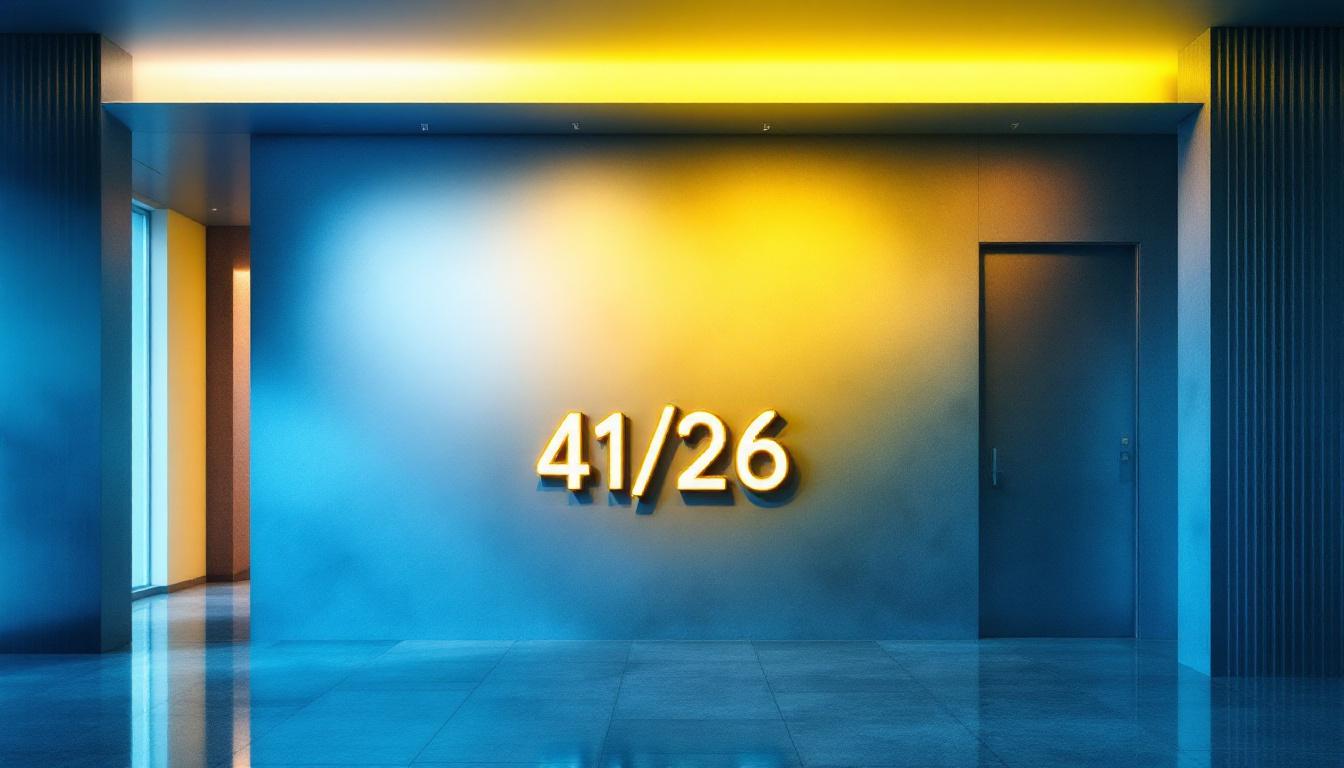
In the ever-evolving lighting industry, terminology and standards often shape the way contractors approach their projects. One such term gaining traction is “41/26.” While it might seem cryptic at first glance, 41/26 represents a significant shift in lighting technology and standards that is poised to redefine efficiency, quality, and sustainability in lighting installations.
At its core, 41/26 refers to a specific performance benchmark related to lighting efficacy and color rendering, combining two critical metrics that lighting contractors prioritize: luminous efficacy (measured in lumens per watt) and color rendering index (CRI). This dual focus ensures that lighting solutions not only save energy but also deliver superior visual quality.
For lighting contractors, understanding the implications of 41/26 is essential. It’s not just about installing lights—it’s about delivering value through smarter, more efficient, and visually pleasing lighting systems that meet the demands of modern clients.
Moreover, the adoption of the 41/26 standard can significantly impact the design and planning phases of lighting projects. By adhering to these benchmarks, contractors can create lighting designs that enhance the aesthetic appeal of spaces while also ensuring compliance with energy regulations. This is particularly relevant in commercial settings, where the ambiance can directly influence customer experience and employee productivity. For instance, a well-lit retail environment that adheres to the 41/26 standards can attract more customers and encourage longer visits, ultimately boosting sales.
Additionally, the move towards 41/26 aligns with the broader industry trend towards sustainability. As energy efficiency becomes increasingly important, the lighting industry is under pressure to minimize its environmental footprint. By utilizing products that meet or exceed the 41/26 benchmarks, contractors can contribute to reducing energy consumption and greenhouse gas emissions. This not only benefits the planet but also positions businesses as leaders in sustainability, appealing to a growing demographic of eco-conscious consumers and organizations seeking to enhance their corporate social responsibility initiatives.
Luminous efficacy measures how well a light source converts electrical power into visible light, expressed in lumens per watt (lm/W). The “41” in 41/26 signifies a benchmark efficacy level of 41 lm/W, which is a substantial improvement over many traditional lighting sources.
Achieving 41 lumens per watt means that lighting fixtures consume less energy while producing the same or greater amount of light. This is crucial for contractors aiming to meet increasingly stringent energy codes and sustainability goals. For example, compared to older incandescent bulbs that typically offer around 10-15 lm/W, a 41 lm/W rating represents nearly a threefold increase in efficiency. This remarkable advancement not only reduces energy bills for consumers but also contributes to lower carbon footprints, making it an attractive option for environmentally conscious projects. As energy costs continue to rise, the economic benefits of adopting such efficient lighting solutions become even more compelling, providing a strong incentive for both residential and commercial sectors to transition to modern lighting technologies.
The “26” refers to a CRI value of 26, which might seem low compared to the typical CRI scale that runs up to 100. However, within the context of 41/26, this number is part of a specialized metric that balances energy efficiency with acceptable color quality for specific applications.
Color Rendering Index measures how accurately a light source reveals the colors of objects compared to natural light. While high CRI values (80-90+) are preferred for retail or hospitality settings, certain industrial or outdoor applications prioritize energy savings and durability over perfect color fidelity. The 26 benchmark represents a new category of lighting solutions optimized for these use cases, offering contractors a reliable option for projects where color precision is less critical but efficiency and lifespan are paramount. For instance, in warehouses or manufacturing facilities, the primary goal is often to illuminate large spaces effectively while minimizing operational costs. Here, a lower CRI can be acceptable, as the focus shifts from aesthetics to functionality. Moreover, advancements in LED technology are continually improving the performance of low-CRI lights, making them more versatile and suitable for a wider range of applications than ever before.
One of the most compelling reasons 41/26 is transforming the lighting industry is its focus on practical energy efficiency. Lighting contractors are under constant pressure to reduce energy consumption without compromising performance. The 41 lm/W efficacy standard embedded in 41/26 ensures that lighting installations consume significantly less power, which translates to lower operational costs for clients.
Moreover, this efficiency does not come at the expense of durability or maintenance. Many 41/26-compliant fixtures are designed with advanced LED technologies and robust components that extend service life, reducing replacement frequency and labor costs—key considerations for contractors managing large-scale or hard-to-access installations.
Lighting contractors often work across a spectrum of environments—from warehouses and factories to parking lots and street lighting. The 41/26 standard provides a tailored solution that meets the unique demands of these settings. For instance, in industrial environments where color accuracy is less critical, 41/26-compliant fixtures provide sufficient illumination to ensure safety and productivity while maximizing energy savings.
Additionally, the standard’s flexibility allows contractors to specify lighting solutions that align with client priorities, whether that’s reducing carbon footprint, lowering energy bills, or complying with local regulations. This adaptability makes 41/26 a versatile tool in the contractor’s arsenal.
With governments and regulatory bodies worldwide tightening energy efficiency standards, lighting contractors must stay ahead of compliance requirements. The 41/26 benchmark aligns well with many energy codes and sustainability initiatives, including incentives for green building certifications like LEED and WELL.
By adopting 41/26-compliant lighting products, contractors can help clients achieve certification credits and demonstrate environmental responsibility. This not only enhances the contractor’s reputation but also opens doors to new business opportunities in the growing market for sustainable infrastructure.
Industrial facilities often require high-intensity lighting that is reliable and cost-effective. Several contractors have reported significant savings after retrofitting older metal halide or fluorescent fixtures with 41/26-compliant LED systems. These projects typically see energy reductions of 40-50%, alongside improved lighting uniformity and reduced maintenance downtime.
One notable example involved a large manufacturing plant that replaced its outdated lighting with 41/26-rated fixtures. The upgrade not only cut energy consumption by nearly half but also improved worker safety by providing consistent illumination across the production floor. The contractor managing the project highlighted the ease of installation and the quick return on investment as key benefits.
Municipalities and contractors responsible for outdoor lighting have embraced 41/26 standards for streetlights and parking lot illumination. The balance between efficacy and color rendering allows for safer nighttime environments without excessive energy use.
In a recent city-wide lighting upgrade, contractors utilized 41/26-compliant LED streetlights to replace aging sodium vapor lamps. The result was a 45% reduction in energy costs and a noticeable improvement in visibility and public safety. Additionally, the longer lifespan of these fixtures reduced maintenance cycles, saving taxpayer money and minimizing traffic disruptions.
Commercial warehouses benefit greatly from lighting solutions that combine efficiency with adequate color rendering for inventory management and safety. Contractors working in this sector have found 41/26-rated lighting to be a perfect fit, providing bright, energy-efficient illumination that supports operational needs.
One contractor reported that after installing 41/26-compliant fixtures, the warehouse experienced fewer lighting-related complaints from staff and a measurable drop in electricity bills. The fixtures’ compatibility with smart lighting controls further enhanced energy savings by enabling occupancy-based dimming and scheduling.
Before specifying 41/26-compliant lighting, contractors should conduct a thorough assessment of the project’s lighting needs. Consider factors such as the environment, required color accuracy, energy consumption targets, and maintenance constraints. This ensures that 41/26 solutions are applied where they deliver the most value.
Engaging clients early in the decision-making process helps align expectations and highlights the benefits of adopting this new standard. Providing data on energy savings, lifecycle costs, and compliance advantages can facilitate buy-in and smooth project approval.
Not all lighting products labeled under the 41/26 standard are created equal. Contractors should carefully evaluate product specifications, certifications, and manufacturer reputations. Look for fixtures that have been independently tested and verified to meet the 41 lm/W efficacy and the 26 CRI benchmark.
Partnering with manufacturers who offer robust warranties and technical support can also mitigate risks and ensure project success. Additionally, consider products that integrate well with existing control systems to maximize energy management capabilities.
Proper installation is critical to realizing the full benefits of 41/26-compliant lighting. Contractors should follow manufacturer guidelines closely, paying attention to factors such as fixture placement, mounting height, and wiring quality.
Incorporating lighting controls such as dimmers, motion sensors, and daylight harvesting can further enhance efficiency. Training installation teams on the nuances of these new products ensures consistent quality and reduces the likelihood of post-installation issues.
The introduction of the 41/26 standard marks a pivotal moment in the lighting industry’s journey toward smarter, greener solutions. By balancing high luminous efficacy with application-specific color rendering, it offers a pragmatic approach that meets the diverse needs of contractors and their clients.
As technology continues to advance, it is expected that the principles embodied by 41/26 will inspire further innovation—leading to lighting systems that are even more efficient, adaptable, and user-friendly. For lighting contractors, staying informed and embracing these developments will be key to maintaining a competitive edge and delivering exceptional value.
Ultimately, 41/26 is more than just a technical specification; it is a strategic framework that empowers contractors to build the future of lighting—one that is sustainable, cost-effective, and tailored to real-world demands.
Ready to embrace the future of lighting with the innovative 41/26 standard? At LumenWholesale, we provide lighting contractors with the highest quality, spec-grade lighting products at competitive wholesale prices. Say goodbye to unnecessary markups and hello to a vast selection of lighting solutions that meet rigorous industry standards. With LumenWholesale, bulk buying is a breeze, and with free shipping, you can rest assured that you’re getting premium lighting at the best value — all with the convenience and reliability you deserve. Don’t miss out on the opportunity to enhance your lighting projects. Wholesale Lighting at the Best Value is just a click away.

Discover essential insights and expert tips for lighting contractors in “Lamp Post: Lighting Contractors Should Know.” This article delves into the latest trends, technologies, and best practices in the industry, ensuring your projects shine brightly and efficiently.

Discover how understanding the intricate parts of a ceiling fan can give lighting contractors a competitive edge in the industry.

Discover how investing in professional lighting contractors for your front porch can illuminate more than just your home.

Discover the essential guidelines for lighting contractors when working with amber color light.